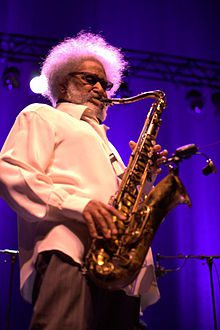Background
Sonny Rollins was born “Theodore Walter Rollins” on September 7, 1930 in New York City. As a child, he started as a pianist, but then switched to the alto saxophone to emulate Louis Jordan. But at the age of 16, he switched again to the tenor saxophone, inspired by his idol Coleman Hawkins.
After graduating high school he began to play professionally and worked with musicians such as the pianist Bud Powell, the trumpeter Fats Navarro, and the drummer Roy Haynes, usually playing bebop. Eventually, he would later befriend trumpeter Miles Davis and the two would later collaborate on Davis’ “Dig” album. He briefly was apart of the Miles Davis Quintet in 1955, but later that year he joined the Clifford Brown-Max Roach Quintet.
In 1956 he began recording under his own name. Then, in 1957 he started the music style of “strolling”, which was just using bass and drums as an accompaniment with the saxophone instead of a piano. Sunny Rollins would take unconventional songs and use them as roots for his improvisation in songs.
In 1959 until 1961, Rollins took a sabbatical from the music industry to focus on improving his craft. Once he returned, every album he created after varied vastly from the previous album. He was regarded as one of the most adventurous musicians of the time.
In 19772, Rollins signed with Milestone and released the album entitled: “Next Album”. While at Milestone, he produced two dozen albums which were produced in different settings :some songs were made in the studio, solo recitals, and others were on the concert stage. He also made songs in which he worked in groups with : Tommy Flanagan, Jack DeJohnette, Stanley Clarke, and Tony Williams. Rollins also had tour recordings in the albums with the Milestone Jazzstars, which included musicians: Ron Carter and McCoy Tyner.
By the 1980s, Rollins had stopped playing in small nightclubs and mainly played in concert halls and outdoor arenas.
Legal Troubles
Early in his career, before he began recording with Miles Davis, Sunny Rollins was convicted in early of 1950 for armed robbery and spent ten months in the Rikers Island jail. Sooner after he was released on parole, he was rearrested in 1952 for violating his probation for using heroin. He then entered the Federal Medical Center for his heroin addiction in 1955. There he volunteered for the experimental methadone therapy and was cured of his heroin addiction.
List of Awards Received:
- Honorary Doctorates of Music from:
- Wesleyan University
- Julliard School
- University of Hartford
- Duke University
- New England Conservatory of Music
- Berklee College of Music
- Long Island University
- Rutgers University
- Colby College
- Honorary Doctorate of Arts from Bard College
- Inducted into the Academy of Achievement
- Lifetime Achievement Award from the National Academy of Recording Arts and Sciences
- Austrian Cross of Honor for Science and Art, First Class
- First jazz composer to be named the Edward MacDowell medalist
- 2 Grammys
- Polar Music Prize
- National Medal of Arts
- Kennedy Center Honors


